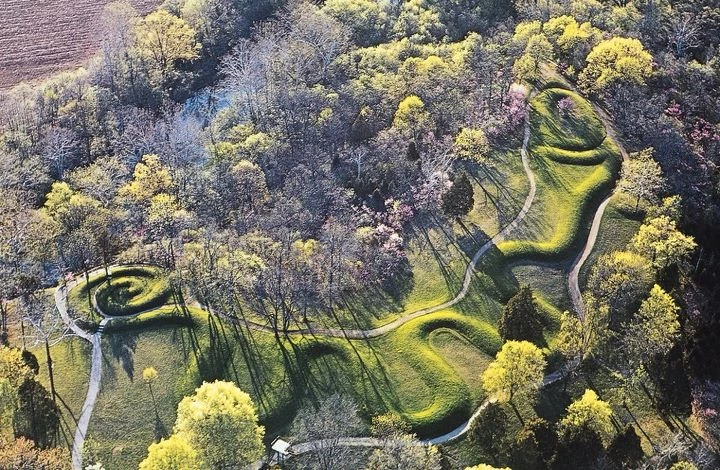


A large zigzag landscape rolls and slips over a prominent summit surrounded by steep wooded slopes and steep cliffs in Adams County, Ohio. The Grand Serpent Mount is a low and rounded terraplen of just over 380 meters long, 6 meters wide and 1,20 meters high. It is like a snake that stretches as it challenges, with seven rings stretched out and three rings wrapped in the tail.
Although we do not know who built this monumental building, it is possible that it was created by the culture of Adena, which flourished in the area between 500 BC and 200 AD. Although no dateable objects have been discovered in the snake itself, 122 meters away there is a conical-shaped sepulchre mound that is related to the culture of Adena. A characteristic of both Adena's and later Hopewell's culture was the construction of mounds.
In 1886, the terraplen suffered severe damage due to the activity of treasure-seekers and curious, in addition to the deterioration caused by soil erosion. When P. W. Putnam of Harvard University's Peabody Museum rescued and restored the site, the monument seemed destined to become a maize.
The Grand Serpent Hill became a state park in 1900 and a viewpoint was built for visitors. Currently, the monument, despite its official character, is threatened by urbanists who want to rebuild the Brush stream and build an artificial lake and a spa near the site, as well as by oil and mining companies that could destroy the mound for gas, oil and uranium.
The terraplen is so extensive that it can only be seen in its entirety from the air. The large amount of land that was moved, possibly in baskets, to build the efigie proved that the builders were very efficient and well organized. Per hundreds of people took many years to finish the work.
It is perceived that the figure holds a large oval object between its jawbones. The mound is believed to be a snake that eats an egg. In many Aboriginal cultures of the United States, ofidiums play an important role, which has generated a variety of theories about the meaning of mounds. Because of the lack of solid evidence, any assumption about the precise function and purpose of the Great Snake Mount is purely speculative.
It is possible that the mound was created by the Adena culture, whose name comes from another Ohio site. The cultures of Adena and Hopewell, which later appeared in the Illinois and Ohio regions, built large tombs for large-sized people.
 Native American Cultures: Myths and magic
Native American Cultures: Myths and magic
You can purchase this book on Amazon.
This book challenges deep-seated stereotypes and offers an enriching perspective that contributes to a more comprehensive and respectful appreciation of the indigenous peoples of North America. Through an understanding of their myths and beliefs, we are taking an important step toward cultural reconciliation and the recognition of the diversity that has enriched the history of this continent.
These mythical stories, many of them linked to the literary genre of fantasy, reveal a world where the divine and the human intertwine in narratives that explain the cosmic order, creation, and the fundamental structure of the universe. Discover how these sacred tales bear witness to the deep connection of the natives with nature and spirituality.
Native Americans: Population and Territories
Native Americans: Cultures, customs, worldview
Traditions, myths, stories and legends